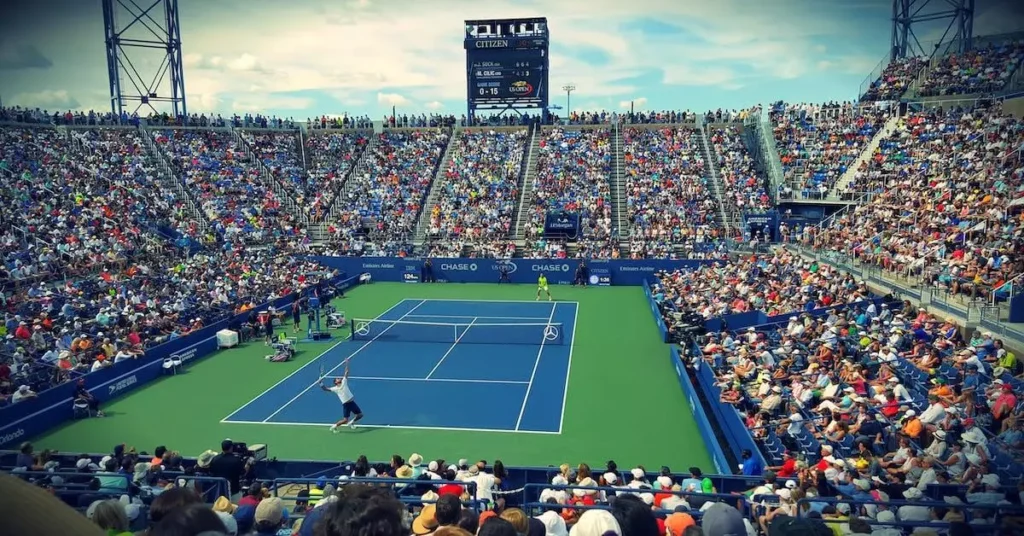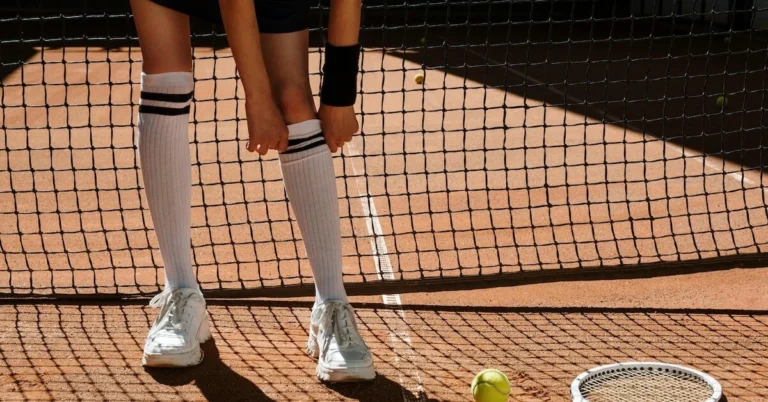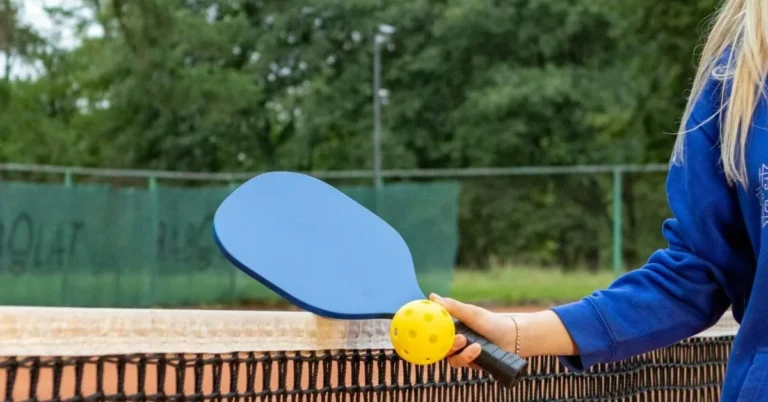Today, we’re diving into the strategic world of timeouts in tennis, where the game takes a momentary breather, and players unleash their inner Zen masters—or maybe just catch their breath between epic volleys.
Timeouts in tennis: the unsung heroes of the court, the brief intermissions where players consult with coaches, reevaluate life choices, and occasionally ponder the meaning of existence (or at least the score). In this uproarious yet informative guide, we are here to unravel the mysteries, the dramas, and the occasional comedy that unfolds during those precious ticking moments.
So, buckle up your tennis shoes and prepare for a rollercoaster ride through the world of timeouts—because when the clock pauses, the real game begins.
Understanding Timeouts in Tennis
Timeouts in tennis are an essential aspect of the game that allows players to take a break from the match and receive medical attention or coaching advice. There are two types of timeouts in tennis: medical timeouts and coaching timeouts.
Medical Timeouts in Tennis
Medical timeouts are taken when a player sustains an injury or falls ill during a match. A player can request a medical timeout by calling for the trainer, and the chair umpire must approve the request. The length of a medical timeout depends on the severity of the injury and whether the treatment can be done on the court or off the court. According to the rules, a medical timeout can last up to three minutes, but in some cases, the player may require more time to recover.
Coaching Timeouts in Tennis
Coaching timeouts, also known as strategic timeouts, are taken when a player needs to consult with their coach during a match. A player is allowed one coaching timeout per set, and the coach must be seated in the player’s box. The timeout lasts for one minute, and the coach is not allowed to communicate with the player during the match unless the player calls for a timeout.
Time Violations
In addition to medical and coaching timeouts in tennis, there are time violations that can occur during a match. A time violation happens when a player takes too much time between points. A player has 25 seconds between points to serve. If a player exceeds this time limit, they receive a warning, and if they exceed it again, they lose a point.
Gamesmanship
Some players use timeouts as a strategy to disrupt their opponent’s momentum or take a break when they are losing. This tactic is known as gamesmanship and is frowned upon in the tennis community. The rules state that players must take timeouts for legitimate reasons and not use them as a tactic to gain an advantage.
The Role of Players
In tennis, players play a crucial role in determining when a medical timeout is necessary. If a player is injured or feels unwell, they can request a medical timeout. However, the decision to grant a medical timeout ultimately rests with the chair umpire.
Players are expected to be honest and transparent when requesting a medical timeout. In 2017, Victoria Azarenka was criticized for taking a lengthy medical timeout during her match against Sloane Stephens at the US Open. Azarenka later admitted that she took the timeout to “calm down and get herself together”. This incident raised questions about the ethics of taking a medical timeout for strategic reasons.
Similarly, Novak Djokovic was accused of using medical timeouts to gain an advantage during his match against Jelena Ostapenko at the 2021 French Open. Djokovic took two medical timeouts during the match, which Ostapenko claimed disrupted her rhythm. Djokovic defended his actions, stating that he was genuinely injured.
Players must also be aware of the rules surrounding medical timeouts. For example, a player is only allowed one medical timeout per injury or illness. Additionally, a medical timeout cannot be taken during a tiebreak. Ajla Tomljanovic was penalized for taking a medical timeout during a tiebreak at the 2021 US Open.
Medical Timeouts in Tennis
A medical timeout is a break in play that allows a player to receive medical treatment for an injury or ailment. The medical timeout rule allows an injured player to receive treatment on the court for up to three minutes. The player must receive permission from the chair umpire before calling a medical timeout.
The length of the medical timeout will depend on the player’s injury, where it is on their body, and whether the treatment can take place on the court or not. For example, if a player is experiencing cramping, they may need to receive treatment on the court, while a player with a more acute injury may need to be taken off the court for treatment.
Bleeding is another condition that may require a medical timeout. A bleeding timeout is related to a medical timeout, but it has slightly different rules. The timeout can last up to 15 minutes, or until visible bleeding has stopped. Tournament officials may also need additional time to clean up the court and sanitize that area.
During a medical timeout, a doctor or medical professional may be called to evaluate the player’s injury and provide medical treatment, such as taping, bandaging, or massaging the affected area. The player may also receive medication or injections to help manage pain or inflammation.
It is important to note that a player may only call for two medical timeouts per match. The maximum amount of treatment time is 15 minutes total for all treatable conditions. Bleeding is one example of a situation where more time can be granted.
Role of Tournament Officials
Tournament officials play a critical role in ensuring that timeouts in tennis are taken in accordance with the rules of tennis. These officials include umpires, chair umpires, and other tournament officials who are responsible for overseeing the match.
One of the key responsibilities of tournament officials is to ensure that timeouts are taken at the appropriate times. This includes ensuring that players take timeouts during changeovers and that they do not take timeouts at other times during the match. Officials must also ensure that players do not take timeouts for reasons that are not allowed under the rules of tennis.
In addition to ensuring that timeouts are taken at the appropriate times, tournament officials are also responsible for enforcing the rules of tennis during timeouts. This includes ensuring that players do not receive coaching during timeouts and that they do not receive any other type of assistance that is not allowed under the rules of tennis.
Tournament officials must also be aware of the different types of timeouts that are allowed under the rules of tennis. For example, players are allowed to take a medical timeout if they are injured or experiencing a medical issue. Officials must ensure that players take these timeouts only when necessary and that they do not abuse this rule.
Timeouts in Tennis: Controversies and Changes

Timeouts in tennis have been a source of controversy for a long time. The ATP has been reviewing changes to the rules around toilet breaks and medical timeouts due to ongoing debates about gamesmanship and the spirit of the game.
At the 2021 US Open, the issue of medical timeouts and toilet breaks was brought to the forefront when Stefanos Tsitsipas took an extended break during his match against Andy Murray. Tsitsipas received a warning for taking too long, but the incident raised questions about whether players should be allowed to take long breaks during matches.
There have been calls to change the rules around medical timeouts and toilet breaks to prevent players from gaining an unfair advantage. Tennis officials are considering implementing stricter rules, such as requiring players to retire if they take too many medical timeouts or toilet breaks.
While some argue that these changes are necessary to maintain the integrity of the game, others believe that they would be too restrictive and could lead to unintended consequences.
Despite the controversies surrounding timeouts in tennis, rule changes are expected to be implemented in the future to address the issue. It remains to be seen what these changes will be and how they will affect the game.
In-Game Strategies and Fairness
Players often use timeouts in tennis as a strategic tool to break the momentum of their opponents. This tactic is known as gamesmanship, and it is a controversial aspect of the game. While some players use it to gain an advantage, others view it as unsportsmanlike behavior.
To ensure fairness, the International Tennis Federation (ITF) has strict rules regarding timeouts in tennis. Players can request a medical timeout if they have an injury or a medical condition that requires immediate attention. The chair umpire will then evaluate the situation and may allow up to three minutes of on-court treatment.
However, players are not allowed to use timeouts in tennis to disrupt their opponents’ momentum or to gain an unfair advantage. If a player takes too long to serve or change ends, they may receive a time violation warning or penalty. This rule ensures that the game flows smoothly and that players do not waste time unnecessarily.
During changeovers and set breaks, players can take a break to rest, rehydrate, and switch sides of the court. The ITF allows players 90 seconds to rest during changeovers and 120 seconds between sets. This time limit ensures that the game moves along at a reasonable pace and that players have enough time to recover between sets.
Timeouts in Tennis: Specific Tournament Rules
Each tennis tournament has its own specific rules regarding timeouts. For example, the US Open allows players to take one medical timeout per match, which lasts up to three minutes. If a player needs more time for medical treatment, they must retire from the match. Additionally, the US Open has a heat rule, which allows players to take a 10-minute break between the second and third sets if the temperature reaches a certain level.
The Australian Open also allows players to take one medical timeout per match, which lasts up to three minutes. However, if a player requires more than one medical timeout, they must forfeit the match. The Australian Open also has a heat policy, which allows players to take a 10-minute break between the second and third sets if the temperature reaches a certain level.
In general, tournaments have strict rules regarding the use of timeouts in tennis. Players are not allowed to use timeouts in tennis as a tactic to disrupt their opponent’s momentum or to gain an unfair advantage. If a player is found to be abusing the timeout system, they may be penalized or disqualified from the tournament.
It is important for players to familiarize themselves with the specific timeout rules of each tournament they participate in. This will help them to avoid any misunderstandings or penalties during the match.
Timeouts in Tennis: Injury Treatment and Evaluation
Injuries are a common occurrence in tennis, and players are allowed to take a medical timeout to receive treatment or evaluation. If a player suffers from an injury that requires treatment, they can call a medical timeout. During this time, a trainer or physiotherapist can evaluate the injury and provide medical treatment if necessary.
According to the rules, a player can have a maximum of two medical timeouts per match if the injury is treatable. However, if the injury is so severe that it can’t be treated any further, then the player will have to withdraw and forfeit the match. The maximum time allowed for both evaluation and treatment is 15 minutes.
The player can call a medical timeout for a variety of injuries, but not all ailments qualify. For example, a player cannot call a medical timeout for fatigue or cramping. They can only do so for injuries that require medical attention, such as a locked rib or a muscle strain.
During a medical timeout, the physiotherapist or trainer may use tape to support the injured area or provide other medical treatment. If the player is bleeding, they may also take a bleeding timeout, which is related to a medical timeout but has slightly different rules. The timeout can last up to 15 minutes or until visible bleeding has stopped.
Timeouts in Tennis: Changes and Adjustments

Tennis has undergone several changes and adjustments in recent years, including changes to the rules surrounding timeouts. One of the most notable changes was the introduction of the shot clock, which limits the amount of time a player has between points. This change was implemented to speed up the game and reduce the number of lengthy matches.
Another significant change was the adjustment to the time limit for changeovers. In 2018, the ATP reduced the time limit from 90 seconds to 60 seconds, a decision that was met with mixed reactions from players and fans alike. However, the reduction in time was intended to make matches more efficient and to reduce the amount of time players spend between points.
In addition to time limits, there have also been changes to the rules surrounding change of ends. Previously, players were allowed to take a bathroom break or medical timeout during the change of ends, which could lead to lengthy delays. However, the ATP has since introduced stricter rules surrounding these timeouts in tennis, with players now required to take them during the set break or risk losing a point.
One player who has been at the center of controversy surrounding timeouts in tennis is Stefanos Tsitsipas. In 2021, Tsitsipas was accused of taking extended bathroom breaks during his matches, leading to calls for stricter rules surrounding timeouts. The ATP has since reviewed the rules surrounding bathroom breaks and medical timeouts, with changes expected to be implemented ahead of the 2022 season.
FAQ
What are the rules for medical timeouts in tennis?
Medical timeouts in tennis are allowed in matches to give players a chance to receive medical attention for an injury or illness. According to the United States Tennis Association (USTA), a player may request a medical timeout when they are experiencing a medical condition that requires immediate attention. A medical timeout shall begin when a player states the need for one. A maximum of three minutes is allowed for a medical timeout. His/her opponent(s) may begin timing the three minutes after which play must resume immediately or the match must be retired. A player may not take more than one medical timeout for the same condition.
What is the time limit between points in tennis?
The time limit between points in tennis is 25 seconds. According to the USTA, the server has 25 seconds to serve the ball after the point is over. If the server takes longer than 25 seconds, they will receive a warning. If they take longer than 25 seconds again, they will receive a time violation penalty.
When is a player allowed to take a medical timeout during a match?
A player is allowed to take a medical timeout during a match when they are experiencing a medical condition that requires immediate attention. The player must request the medical timeout as soon as possible and should not use it as a tactic to disrupt the opponent’s momentum. A player may not take more than one medical timeout for the same condition.
We’ve delved into the intriguing world of timeouts in tennis. Whether it’s a strategic breather, a medical necessity, or a mind game in disguise, timeouts add an extra layer of drama to the game we love.
So, what’s your take on timeouts in tennis? Have you witnessed any memorable timeout moments or perhaps experienced some amusing timeout shenanigans yourself? Share your thoughts, anecdotes, or even your wittiest timeout-related jokes in the comments below!






